Global Internet Censorship: The Current State of Platform Access and Digital Freedom
Editor’s Note: TikTok was nearly banned in the United States, and it could happen again. You’ll need a good VPN to maintain access to your favorite content creators. ExpressVPN is the #1 TikTok VPN, offering a reliable connection to the app.
Society’s growing reliance on online spaces has transformed our approach to work, study, leisure, and overall way of living. However, issues of suppression, restriction, and censorship also arose with it. Over time, access to popular platforms online has become an indicator of countries’ democratic health.
This topic falls squarely within our focus at WizCase: online privacy, cybersecurity, and how individuals can confidently and safely make the most of the digital world. In this vein, we wanted to see how access to popular platforms correlates to governments’ attitudes toward democracy and self-expression, as well as identify patterns based on political regimes.
By studying what types of platforms are blocked in certain countries, our team hoped to assess how citizens’ internet freedom is affected. We also aimed to gain insight into how governments potentially leverage online access to bolster their political motivations or undermine other countries’ power.
Key Takeaways
- Countries with autocratic tendencies are more likely to ban online platforms. For example, North Korea and China scored 0 and 6 points, respectively.
- Self-restriction impacts platforms’ accessibility in many countries. Media streaming services have the lowest average worldwide availability at 66.97%, followed by fintech and blockchain at 80.66%.
- Asian countries have the most restrictions on popular platforms, with 21 out of the 35 bottom nations coming from the continent.
- South America arguably performed the best, with several countries scoring 86 out of 87 and only one country scoring below 78 points.
Note from our team: Please don’t hesitate to contact us if you need clarifications regarding the research or would like further analyses. We’ll gladly give you any additional information that’s within our capacity to provide.
Platform Access Analysis by Category
In this research, we studied the accessibility of different platforms across 195 countries included in the United Nations’ official list. We prioritized the types of platforms that can potentially be harnessed for political gains (e.g., social media, content streaming, news reporting) and excluded those that may be considered more “neutral” or overall less popular (e.g., crowdfunding, gaming).
Ultimately, we considered 87 platforms grouped into 10 main categories, dividing them based on their primary functions and the nature of their services or purpose. We also gave each country a censorship score: 1 point for every platform that’s fully available and zero for platforms that are banned, heavily restricted, or censored.

Social & Messaging
Out of 195 countries, 164 (84.10%) allow all the social & messaging platforms included in our research. Globally, the average availability for social media and messaging apps is 96.03%.
Social apps and sites are among the most widely used online, presumably because they often combine the functionalities of several categories of platforms. They provide messaging, news aggregation, content streaming, and marketplace capabilities. However, their perceived well-roundedness makes them vulnerable to controversies related to user privacy, propaganda dissemination, misinformation, and bias.
Among the most popular platforms, TikTok is possibly the most controversial. Being owned by the Chinese company ByteDance, the app has been accused of exploiting user data for cyber espionage. TikTok’s main critic is the United States government. Around 40 states have already banned TikTok from government-issued devices, and the federal government has long made clear its intention of blocking the platform nationwide.
Many other countries have levied restrictions against TikTok, with India banning the platform and 58 other Chinese-owned apps due to cybersecurity concerns. In 14 nations, TikTok has been banned from government devices, even though they remain accessible to the general public. Meanwhile, the Russian government heavily restricts TikTok, only allowing content from Russian creators.
TikTok isn’t accessible in China either. Instead, citizens are encouraged to download and use Douyin (the local version of TikTok), which the Chinese government heavily censors. In fact, WeChat is the only social media platform included in our research that’s available in China, and it’s subjected to heavy censorship and surveillance that users from outside the country do not experience.
We must note that several countries have imposed temporary bans on social media platforms, usually amid protests, military campaigns, or other politically sensitive events. This has happened in Spain, Azerbaijan, Russia, and Myanmar, among many others. However, we didn’t include these instances in our study because the blocked platforms in these cases were eventually made available again after a short period.
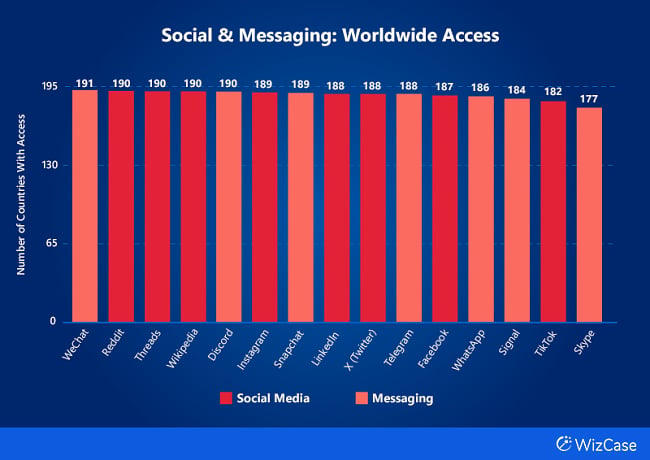
Email Services
Email services are, for the most part, less restricted across the world. Of the countries in our study, 186 (95.38%) allow all the platforms we considered. Moreover, this category has the second-highest average percentage of availability worldwide at 98.03%.
In Russia, Proton Mail was blocked for reportedly refusing to cooperate with the authorities after being asked to provide user information related to alleged bomb threats. Tuta is also banned in the country, which the platform claims is an “act against encryption and confidential communication.”
Microsoft Outlook is the only international email service that’s still operational in China, but users often report difficulties in accessing or connecting to the platform. Microsoft has servers in the country, but it’s likely that China’s “Great Firewall” still impacts the company’s services.
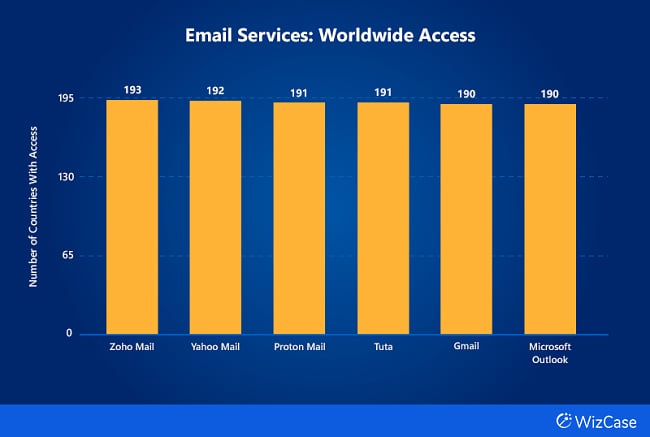
Search Engines
The average worldwide availability for search engines is 98.18% (the highest of all categories), with 183 countries (93.85%) allowing access to all the platforms we studied. Moreover, 5 out of 11 search engines included in our study ranked as some of the highest scorers of all platforms.
Baidu, Mojeek, Startpage, Ecosia, and Yahoo Search are all available in 193 countries. Mojeek is based in the UK, while Startpage is headquartered in The Netherlands; both claim to prioritize people and privacy. Ecosia is popular for its carbon-neutral platform that funds tree-planting across the globe, whereas Yahoo Search is one of the oldest engines that are still active.
On the other hand, Baidu is a Chinese-owned search engine that has, on many occasions, come under scrutiny for allegedly supporting the Chinese government’s political motivations and propaganda. The platform is subject to heavy censorship, so it often omits topics such as Tibetan independence and anything related to Hong Kong democracy. Only India and North Korea have banned access to Baidu.
Yandex, which ranks the lowest in this category, faces similar allegations. As a Russian-owned engine, it’s often accused of manipulating search results to favor pro-Kremlin narratives. It is banned in China, Finland, Latvia, North Korea, Norway, and Ukraine.
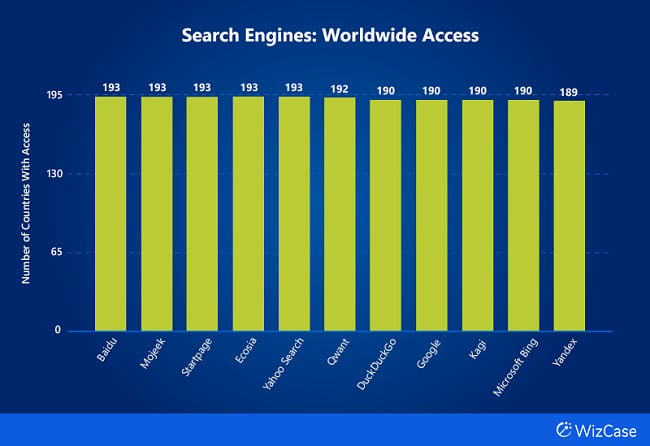
News Sites
Only 151 countries (77.44%) allow access to all news sites and journalist platforms we studied, even with an average worldwide availability of 96.72%. Most platforms we looked at are available in at least 190 countries, even though news sites may be considered inherently contentious or biased. Only two websites face restrictions related to political tensions: Al Jazeera and RT (formerly Russia Today).
5 out of 8 countries that have banned Al Jazeera are in conflict with Qatar, where the site is headquartered. These nations — Bahrain, Egypt, Jordan, Saudi Arabia, and the United Arab Emirates — have accused Al Jazeera of promoting extremism and have demanded its closure. The United States has made similar comments against the site, even though it remains operational in the country.
One of the most recent restrictions on Al Jazeera came from Israel in May 2024. Israeli Prime Minister Benjamin Netanyahu referred to the site as an “incitement channel” when it announced the ban, potentially alluding to the outlet’s coverage of the Palestinian conflict. Al Jazeera called the decision an anti-humanitarian and “criminal act.”
RT is the 13th (out of 87) lowest-ranking platform in terms of worldwide accessibility. The European Union (EU) banned the website in 2022 following Russia’s invasion of Ukraine. At the time of writing, at least 31 countries have restricted access to the news outlet. While the site is accessible in the United States, federal law classified it as a “foreign agent,” so it has to disclose sources of funding and affiliations.
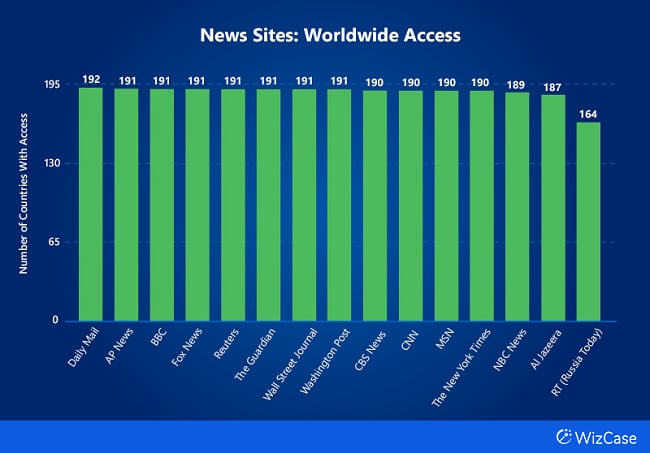
Media Streaming
Only 37 countries (18.97%) allow access to all media streaming platforms in our study, with a 66.97% average worldwide availability — the lowest among all categories. However, this figure isn’t representative of governments’ attitudes toward these services. The accessibility of video and music platforms listed here is mostly influenced by self-restriction rather than government-imposed bans.
For this category, we need to distinguish between the availability of the website, the accessibility of the streaming platform, and the size of the catalog. We’re mostly focusing on platform availability, as that’s what, in practice, users want.
That said, in some cases, platforms’ catalogs are restricted to certain territories, even though their websites are accessible in many countries. For example, HBO Max’s website can be accessed from almost anywhere in the world, but the platform’s streaming services are only available in a handful of regions.
We must note that government policies can also influence platforms’ decisions to self-restrict in some territories. If a country is known to censor certain types of content (e.g., music genres or themes in films), streaming services may become less inclined to expand into those territories. However, we have no definitive way to qualify these instances.
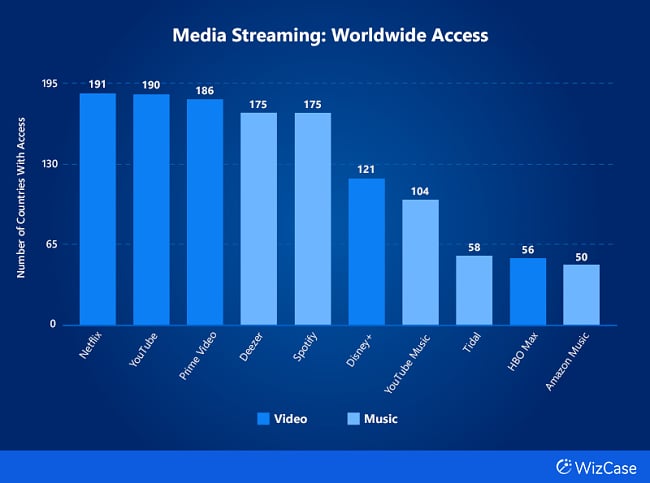
Adult Content
Out of 195 countries, only 160 (82.05%) allow access to all the pornographic websites we studied. Moreover, this category placed in the bottom half of the list in terms of the average percentage of availability (91.54%). Given the polarizing nature of pornography, these results may be considered par for the course.
For instance, it’s not unexpected for Muslim-majority countries to ban adult content, as it may be regarded as contrary to traditional Islamic values. Of the 35 territories that have banned or restricted this category, 19 have a Muslim population of at least 60%.
Some Western countries have also levied tight regulations against pornographic platforms. In the United States, for instance, many regions have mandated adult websites to implement stricter age verification processes. However, the law was criticized for potential privacy issues, as it will compel users to present a government ID or use a third-party digital identification service before accessing the sites.
Moreover, the regulation makes it the pornographic platform’s burden to ensure compliance. The most popular adult website in the country emphasized that “there’s no way to comply with this law” in states without digitized government identification services. As a sign of protest, the platform has blocked users from at least 12 states (at the time of writing). Eleven out of these 12 states are generally considered to be conservative.
In other regions, pornography restrictions may be related to copyright infringement battles, disputes regarding obscenity standards, or regular state censorship.
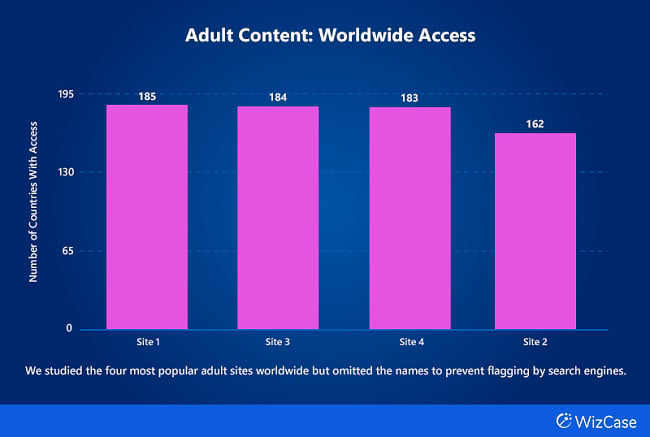
Piracy Sites
Overall, this category scored 93.97% in average worldwide availability, while only 157 countries (80.51%) allow access to all piracy sites listed in this study. Here, we look at the two most common types of online piracy platforms: those that share copyright-protected written content (eBooks, publications, courses, and more) and those facilitating torrent downloads.
The first type includes websites that seek to promote a more democratized distribution of academic resources, with some also offering pirated eBooks of diverse genres. Sci-Hub is likely the most well-known of these sites. It’s a highly debated idea, especially in research and publication circles.
Of the 195 countries on our list, 180 allow access to all platforms that share books or academic resources for free. Library Genesis is the most restricted of the five websites considered in our study. Interestingly, of the 11 countries blocking this website, 8 are European.
The second type of piracy platform includes torrent sites, where different types of content can be distributed in a decentralized, peer-to-peer manner. Torrent platforms offer free content, which is presumably why they remain popular amid the rise of streaming services. These sites may also carry books and publications, but they’re more famous for video and music content.
Notably, the most popular torrent sites continue to be accessible in many countries despite “strict” laws against piracy.
For instance, Germany is typically regarded as the strictest in enforcing anti-piracy regulations, yet 2 of the 3 most popular torrent sites aren’t restricted in the country. Nevertheless, its citizens are often apprehensive about downloading pirated content, as they fear that authorities are monitoring these websites to catch those violating the law.
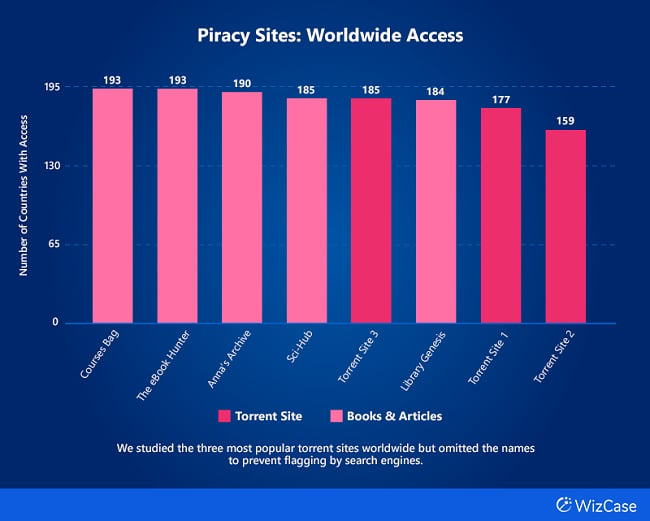
AI Tools
This category scored a 91.45% average worldwide availability, with 122 countries (62.56%) allowing access to all mentioned platforms. We considered the accessibility of popular AI chatbots and image generators online — some platforms only offer image generation capabilities, while many advanced chatbots already come with this feature.
Google’s Gemini is the least accessible worldwide, but this is primarily because of self-restriction. As the platform is relatively new, Google may still be limiting where it’s made available. We also must note that the platform came under fire in the first quarter of 2024 for generating images that depicted historical inaccuracies and racial bias. This may have compelled the company to decelerate Gemini’s rollout and prioritize refining the models’ programming.
On the other hand, Perplexity AI appears to be available in 192 countries, although there isn’t enough information to confirm whether it is fully functional in all those regions. The platform seems to perform similarly to other chatbots or conversational AI assistants like ChatGPT, but it claims to be mainly a search engine that focuses on aggregating information from several online sources.
Most AI image generation platforms are open source, so they’re typically available worldwide, except in countries with strict censorship and firewall policies. This means that restrictions against these AI tools in those territories are a byproduct of governments’ overall regulations rather than a direct ban on the platforms.
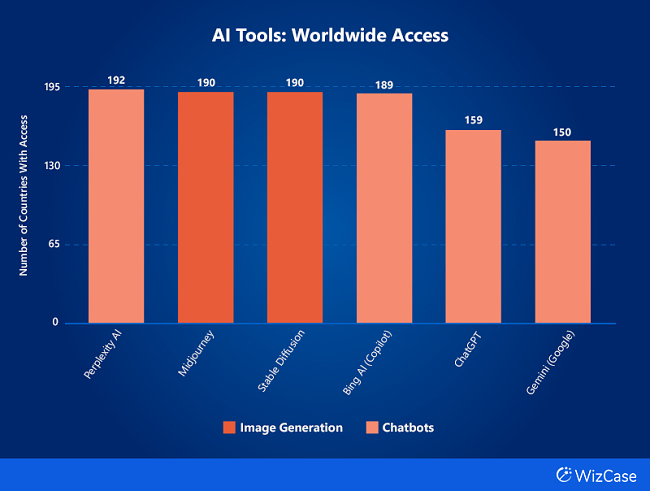
E-Commerce
Only 65 countries (33.33%) allow access to all e-commerce platforms included in our study, becoming the third-lowest scorer in terms of total platform availability. However, this is primarily because Temu has yet to launch in many regions.
Notably, AliExpress is similar to TikTok in that it isn’t available in its “home country.” Instead, Taobao/Tmall — a local version of AliExpress (same parent company) — caters exclusively to Chinese citizens.
Amazon’s case is also peculiar. In 2020, the United States federal government fined the company for accepting orders from citizens or officials in Cuba, Iran, Sudan, and Syria. As a result, Amazon is now self-restricting in countries that are being sanctioned by the United States government.
The rest of the platforms are mostly available worldwide, except in territories with strict internet censorship laws. Overall, e-commerce platforms have an 84.82% average worldwide availability.
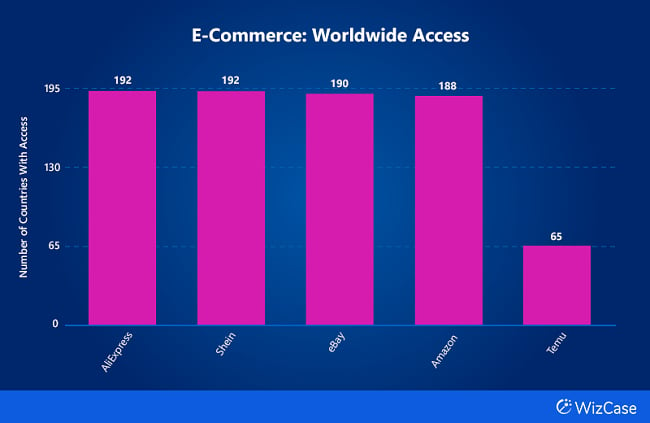
Fintech & Blockchain
Only 33 countries (16.92%) allow access to all platforms listed in this study. Moreover, this category has the second-lowest average percentage of worldwide availability (80.66%). We must note, however, that most fintech and blockchain or cryptocurrency platforms are self-restricting rather than being banned by governments.
Given the nature of their business model, apps or sites that fall under this category are often subject to very strict regulations. This discourages companies from expanding into territories that may not provide substantial ROI.
Measures such as the anti-money laundering (AML) and know-your-customer (KYC) policies can be costly to set up for crypto platforms. It also requires thorough personal data collection to prevent fraud, which can be difficult to balance with user privacy protection in countries with heavy government surveillance.
Lastly, different regions typically have varying licensing requirements for platforms that offer financial services, which can deter companies from entering new markets rapidly.
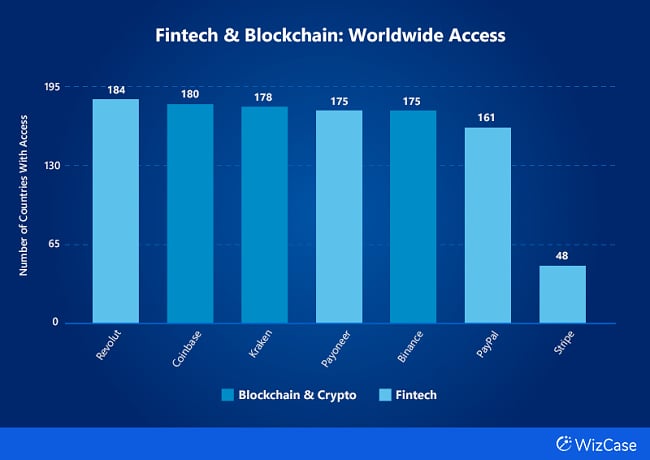
Analysis of Censorship Trends
8 apps and sites shared the top spot as the most widely available platform (193 countries). This includes 2 piracy sites (for books and articles), 1 email service, and 5 search engines. A total of 44 platforms (out of the 87 we studied) are available in at least 190 countries.
On the other hand, only 5 of all the platforms studied were accessible in less than 100 nations. The lowest scorer is fintech company Stripe (available in 48 countries); the rest consist of 3 streaming services and 1 e-commerce website. Of the bottom 10 platforms in terms of accessibility, 5 are streaming services.
In a few categories, worldwide accessibility is primarily affected by self-restriction rather than regime-imposed bans. Still, government policies appear to have a significant influence on platforms’ expansion decisions.
Countries with stricter censorship may seem less appealing to companies, as it exposes them to potential sanctions, legal disputes, or controversies. Similarly, wars or diplomatic conflicts between a platform’s base country and other territories may affect whether the app or site is inclined or allowed to enter the region.
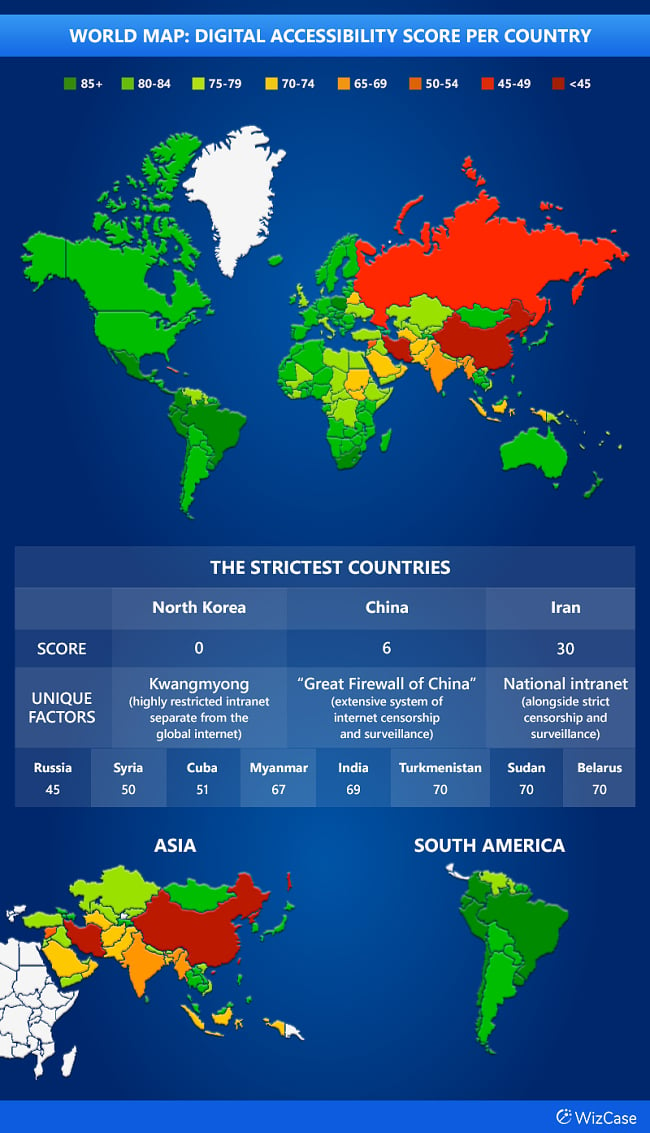
Overall, Asian countries have the most restrictions on popular platforms. In the Asia view of the map above, even countries with a muted green marker performed poorly compared to nations from other continents. Japan scored the highest (83 points), and 21 out of the bottom 35 countries are in Asia.
South America arguably performed the best, with only one country scoring 78 or lower and three countries (Chile, Colombia, and Peru) earning 86 out of 87 points. The country with the best overall scoring is Mexico, where all the platforms we studied are accessible.
By looking at the patterns of restrictions, it becomes undeniable how different governments’ attitudes toward democracy may dictate the level of internet freedom citizens enjoy.
North Korea, the only country to have scored zero, has the longest-standing totalitarian regime that still exists today. Its government aims to strictly control all forms of information dissemination and communication within the country, which necessitates removing global connectivity from the equation. Instead, North Koreans have access to a restricted and censored intranet closely monitored and operated by the regime.
China and Iran also scored very low, and their governments’ goals are quite similar to the North Korean regime’s motivations for censorship: maintain the political status quo by regulating the flow of information.
Conclusion
The research suggests that governments with healthy democratic processes typically do not restrict digital content outright. Instead, platforms may opt out because of sanctions, complicated operational regulations, or diplomatic conflicts.
On the other hand, regimes with high autocratic characteristics (whether absolute or elective) are more likely to restrict digital content for political reasons, as seen in many parts of Asia. As such, our team finds that further study on digital restrictions in countries considered autocratic may yield deeper insight into the geopolitical and social implications of censorship.
For now, it appears that championing true internet freedom will require advocating beyond the digital space. In parts of the world where governments curtail the rights of their citizens, a crucial first step would be to support individuals’ rights to life and freedom and push back against regimes’ despotic tendencies.





Leave a Comment
Cancel